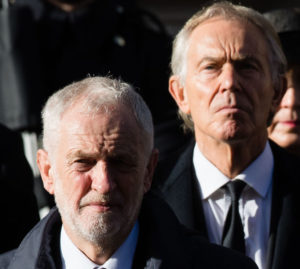
Three days on from the election result and we already have various post-mortems on Labour’s loss. Not many, however, seem to have pointed out that Corbynism, instead of being a definitive break with Blairism, actually represented a strange continuity with the New Labour years.
A rejection, of course, of its neoliberal economics, but a perpetuation of the middle-class sensibility which came to characterise its social policy and cultural positioning.
Corbynism can’t take all the blame; but the so-called ‘centrists’ don’t have any answers either. The 2019 election finally severed Labour from its working-class base, but the drain of those voters away from the party began in the late 1990s. Working-class support for Labour fell from 55% in 1997 to 37% in 2015. By 2017 the more working-class a constituency, the more likely it was to back the Conservatives. Labour’s shift from a party representing working people to a bourgeois liberal party has been a slow process – not a bang, but a whimper. The paradox of the Corbyn project is that it completed the gentrification of the Labour Party that began under New Labour.
Both Corbynism and Labour’s pro-second referendum position are merely symptoms of a much more complex and more deeply entrenched cause: the capture of public institutions, particularly those aligned with or sympathetic to the wider Left movement such as universities, think tanks, and trade unions, by a liberal class with an almost libertarian social intention. A class who, after the economic liberalisation of the 1980s, misunderstood its own organised resistance to the more conservative-minded as a project rooted in the aims and objectives of working people.
In doing so they exhibited the perhaps unavoidable tendency of elites throughout history to universalise their particular interests. This bourgeois liberalism, in both its Blairite and Corbynite forms, which so precisely addressed the socio-economic anxiety of the upper-middle class, was projected onto a working class who did not benefit from its consequences.
High levels of population churn threatened community cohesion, an encroaching globalised economy destroyed decent work, while family breakdown and an attendant mental health crisis overwhelmingly affected the poorest families and children.
As with the vote to leave the EU three and a half long years ago, the working-class Tory vote in this election was, perversely, a vote for sanctuary from this ongoing economic and cultural war. A war which many on the liberal Left, both ‘centrist’ and Corbynite, didn’t realise they were fighting, having considered their side of the argument an objective presentation of the facts rather than a policy choice. A vote to ‘Get Brexit Done’ was to vote against the malaise of this progressive inevitability. So in the upcoming Labour leadership election, remember this: shiny centrism, worn smooth with presumptive power, has as little to say to these voters as the supposedly radical Left.









Join the discussion
Join like minded readers that support our journalism by becoming a paid subscriber
To join the discussion in the comments, become a paid subscriber.
Join like minded readers that support our journalism, read unlimited articles and enjoy other subscriber-only benefits.
Subscribe